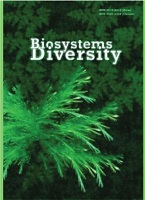Spatio-temporal analysis of North African forest cover dynamics using time series of vegetation indices – case of the Maamora forest (Morocco)
Spatio-temporal analysis of North African forest cover dynamics using time series of vegetation indices – case of the Maamora forest (Morocco)
Author(s): S. Moukrim, A. Benabou, S. Lahssini, A. Aafi, A. Chkhichekh, F. Moudden, M. Ben Bammou, A. El Aboudi, S. LaaribyaSubject(s): Human Ecology, Political Ecology, Environmental interactions
Published by: Дніпропетровський національний університет імені Олеся Гончара
Keywords: cork oak; cover trend; degradation; spatial variability;
Summary/Abstract: North African forest areas play several roles and functions and represent a heritage of great economic and ecological importance. As a result of global changes, that act independently or synergistically, these areas are currently undergoing a pronounced degradation and their productivity is decreasing due to several factors. This work aims to characterize spatio-temporal dynamics of vegetation within the Maamora forest. This forest is considered as the most extensive cork oak woodland in the world and is divided, from west to east, into five cantons A, B, C, D and E. The data, extracted between 2000–2021 from MODIS NDVI/EVI images of 250 m, were analyzed using statistical parameters with the Pettitt homogeneity and the Mann-Kendall trend tests, with their seasonal and spatial components, in order to better consider the vegetation distribution of this forest. Results show a clear temporal and spatial (inter-canton) variability of vegetation intensity, unrelated to the continental gradient. In fact, recorded mean values in cantons C and E are significantly higher than those of cantons B and D respectively. This is confirmed by both regressive and progressive trends, which were identified respectively from the months of March 2012 and October 2008, in the data series of cantons B and E successively. Spatially, the regressive dynamic remains generalized and affects more than 26.7% of the Maamora’s total area with extreme rates (46.1% and 14.0%) recorded respectively by the two aforementioned cantons. Similarly, all the stand types in canton B show the highest regressive rates, especially the cork oak regeneration strata (75.4%) and the bare lands (86.1%), which may explain the positive tendencies identified by the related series during the fall season. However, the cantons C and E record the lowest rates, respectively, for natural stands of cork oak and artificial plantations. These results highlight also the absence of a causal relationship between the contrasting vegetation dynamics of the Maamora and the climatic conditions, expressed here by the continental gradient. However, they do highlight the effects of other factors, particularly those of a technical nature.
Journal: Biosystems Diversity
- Issue Year: 30/2022
- Issue No: 4
- Page Range: 372-379
- Page Count: 8
- Language: English

